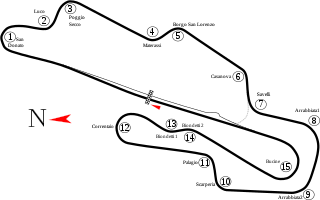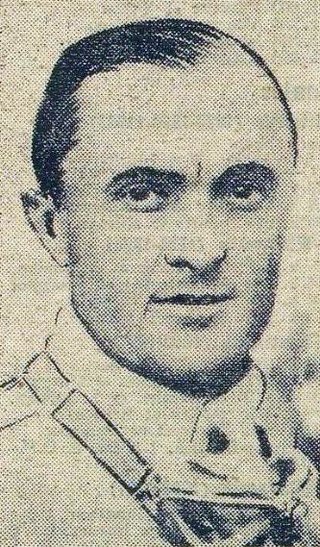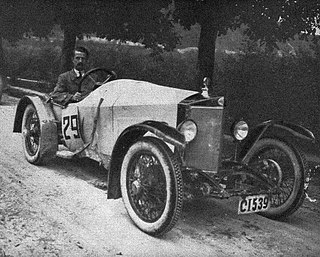
S.P.A. was an Italian automobile, military vehicle and aero-engine manufacturer founded in Turin by Matteo Ceirano and Michele Ansaldi. It was active between 1906 and 1926. In 1908, it merged with Fabbrica Ligure Automobili Genova (FLAG) and the new company, Società Ligure Piemontese Automobili, was headquartered in Genoa while manufacturing in Turin.

Emilio Materassi was an Italian Grand Prix motor racing driver.

The Bugatti Type 51 series succeeded the famous Type 35 as Bugatti's premier racing car for the 1930s. The main distinction is that it uses a twin cam engine. Unlike the dominant Type 35s of the prior decade, the Type 51 were unable to compete with the government-supported German and Italian offerings.

Itala was a car manufacturer based in Turin, Italy, from 1904 to 1934, started by Matteo Ceirano and five partners in 1903.

The Ferrari F2002 was a racing car used by Scuderia Ferrari Marlboro as its entry for competition in the 2002 Formula One season. The chassis was designed by Rory Byrne, Ignazio Lunetta, Aldo Costa, Marco Fainello, Nikolas Tombazis and James Allison and Paolo Martinelli, assisted by Giles Simon leading the engine design and operations, under the overall leadership of Ross Brawn who was the team's Technical Director and Jean Todt the team Manager. It won fifteen Grands Prix, from a total of nineteen races in 2002 and 2003. It is widely regarded as one of the most successful Formula One car designs of all time, as Michael Schumacher drove it to a then record-equaling fifth world drivers' title in 2002, while easily clinching the 2002 constructors' title with as many points as all other teams put together.

Rosso corsa is the red international motor racing colour of cars entered by teams from Italy.

Mugello Circuit is a motorsport race track in Scarperia e San Piero, Florence, Tuscany, Italy. The circuit length is 5.245 km (3.259 mi). It has 15 turns and a 1.141 km (0.709 mi) long straight. The circuit stadium stands have a capacity of 50,000.

The Maserati Mistral is a 2-seat gran turismo produced by Italian car manufacturer Maserati between 1963 and 1970. The successor to the 3500 GT, it was styled by Frua and bodied by Maggiora of Turin. A total of 828 coupés and 125 Spyders were built.

The Maserati 4CL and its derived sister model the Maserati 4CLT are single-seat open-wheel Grand Prix racing cars that were designed and built by Maserati. The 4CL was introduced at the beginning of the 1939 season, as a rival to the Alfa Romeo 158 and various ERA models in the voiturette class of international Grand Prix motor racing. Although racing ceased during World War II, the 4CL was one of the front running models at the resumption of racing in the late 1940s. Experiments with two-stage supercharging and tubular chassis construction eventually led to the introduction of the revised 4CLT model in 1948. The 4CLT was steadily upgraded and updated over the following two years, resulting in the ultimate 4CLT/50 model, introduced for the inaugural year of the Formula One World Championship in 1950. In the immediate post-war period, and the first two years of the Formula One category, the 4CLT was the car of choice for many privateer entrants, leading to numerous examples being involved in most races during this period.
The 1925 Grand Prix season was the first year for the new AIACR World Manufacturers' Championship season. The championship was won by Alfa Romeo, with its P2 model.

The 1926 Grand Prix season was the second AIACR World Manufacturers' Championship season and the first running to new 1.5-litre regulations. The championship was won by Bugatti and its Type 35 was the dominant car of the year.

The 1927 Grand Prix season was the third AIACR World Manufacturers' Championship season and the second run to a 1.5-litre engine limit. In a dominant display, the championship was won by Delage, with team driver Robert Benoist winning four of the five Grand Prix.

The 1928 Grand Prix season saw the Monegasque driver Louis Chiron, and his Bugatti, take seven Grand Prix victories.

The 1928 Italian Grand Prix was a Grand Prix motor race run on 9 September 1928, at Monza. It was run over 60 laps, and was won by Louis Chiron driving a Bugatti 37A. It was the 8th Italian Grand Prix. This race was also the VI Grand Prix d'Europe.

The Cooper T86 was a Formula One racing car built by Cooper and first raced in 1967. B and C specification cars were also built to accommodate different engines, but the car could not revive Cooper's fortunes and this type represents the last Formula One chassis built and raced by the former champion team.
The 1926 Targa Florio was a Grand Prix motor race held on the 108km Medio Circuito Madonie in Sicily, Italy on 25 April 1926. There were two separate races held simultaneously, one for up to 1100cc Cyclecars held over 3 laps for a total distance of 324km, and the main race for Formula Libre cars over 5 laps for a total distance of 540km. The longer race also featured the 1926 Coppa Florio which was open only to factory entered cars. The Cyclecar race was won by Baconin Borzacchini driving a Salmson, while the longer race and Coppa Florio were won by Meo Costantini in his factory entered Bugatti.

Ferrari manufactured a series of 3.0-litre, naturally-aspirated, V10 racing engines, exclusively for their Formula One race cars; between 1996 and 2005. They chose a V10 engine configuration, because it offered the best compromise between power and fuel efficiency; the V12 was powerful but thirsty while the V8 was weaker but economical. They switched to 2.4-litre naturally-aspirated V8 engine configuration for 2006. Over its decade-long evolution, power levels varied; from 715 hp @ 15,500 rpm in 1996, to over 900 horsepower, around 935 hp @ 19,000 rpm, toward the end of the 2005 season. The Tipo 05 series of engines, produced between 2001 and 2005, was officially stated to produce between 825 hp @ 17,800 rpm, and 865 hp @ 18,300 rpm. In qualifying mode, however, these engine were reputed to develop up to, or at times over, 900 horsepower (670 kW) at 19,000 rpm.

Bugatti made a series of Grand Prix, and later Formula One, straight-8 racing engines; between 1922 and 1939, and once again in 1956.

The March 821 was a British Formula One racing car used by the John MacDonald-owned RAM Racing in the 1982 Formula One World Championship. Regardless of its model designation, the car had no connection with long-established race car manufacturer March Engineering. The car did not score any world championship points. Designed by Adrian Reynard, a total of five cars were built. It was also the last Formula One car to bear the "March" name until 1987, with March focusing most of their attention and resources into CART IndyCar racing.

The Steyr Type VI was a series of grand tourer-style torpedo car, designed, developed and built by Austrian manufacturer Steyr, between 1923 and 1926. A sports racing version, known as the VI Klausen, was used in both Formula Libre and Grand Prix racing events.


















